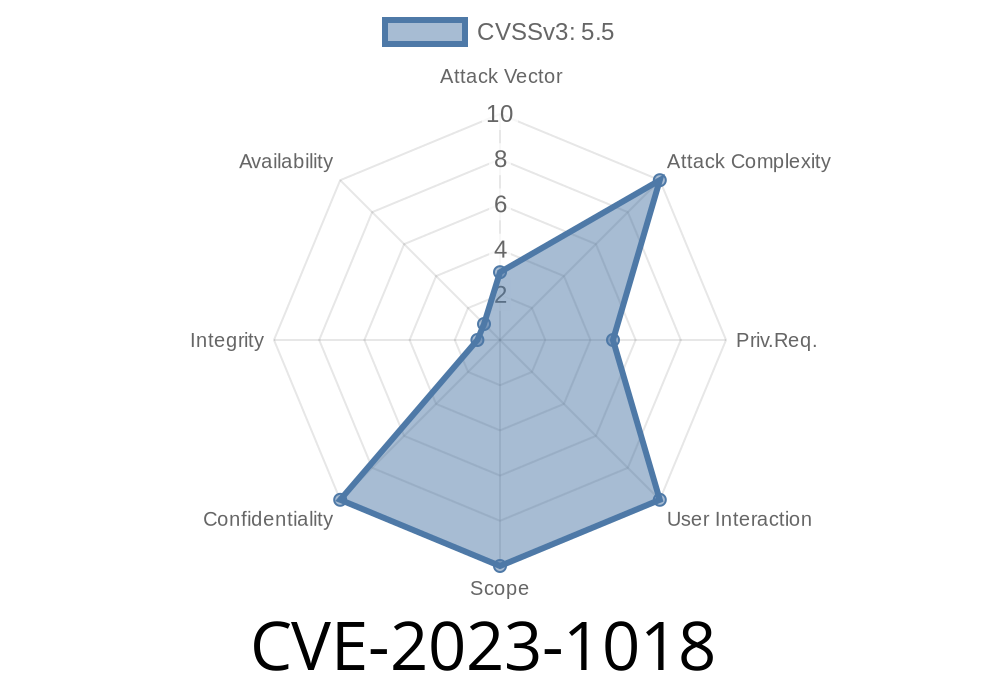---
Introduction: Why TPM Vulnerabilities Matter
Trusted Platform Module (TPM) chips are the keystone of hardware security in most modern systems. They store passwords, encryption keys, and other secrets that keep our devices secure. Unfortunately, when a vulnerability is found in a TPM implementation, it can put all this sensitive data at risk. CVE-2023-1018 is one such problem—a subtle but dangerous out-of-bounds read allowing attackers to peek into the forbidden memory of the TPM itself.
What is CVE-2023-1018?
CVE-2023-1018 is a security issue found in the TPM2. Reference Implementation's library. Specifically, there is an out-of-bounds read in the CryptParameterDecryption routine. The root cause is improper bounds checking, which allows an attacker to read 2 bytes past the intended data buffer in a TPM2. command.
If an attacker can send crafted data to the TPM—for example, through system interfaces or remote management tools—they could use this vulnerability to read sensitive data stored by the TPM, such as cryptographic keys or passwords.
Technical Details: Where’s the Bug?
The bug lives in the command-handling logic in the TPM2. library, right where it handles decrypted parameters. Let’s walk through a simplified version:
// Simplified vulnerable code (do NOT use in production)
TPM_RC CryptParameterDecryption(TPM2B *input, ...)
{
// The buffer is 'input', with a size: input->size
// The routine reads 'size' bytes, but doesn't check bounds
for (size_t i = ; i < input->size + 2; i++) { // Off-by-2 error
process_byte(input->buffer[i]);
}
}
The key issue is that the loop above can access two bytes beyond the input->buffer, if input->size is at the actual end of the buffer. These bytes could contain sensitive data left by previous operations, or even cryptographic secrets.
How Can It Be Exploited?
An attacker with access to the commands sent to the TPM can exploit this bug by carefully crafting the input buffer size and content. For example, the attacker could:
The TPM library will process up to size + 2 bytes, leaking 2 bytes beyond the expected data.
3. Read back the response or observe resulting behavior (e.g., via error codes, side channels, or even directly returned data in certain situations).
Over multiple tries, an attacker might piece together sensitive data that should have been protected inside the TPM.
Here’s a simplified pseudo-PoC (not an actual exploit, just for educational purposes)
import struct
# Prepare a TPM2. command buffer at maximum size
payload = bytearray([x00] * 256) # Typical buffer, 256 bytes
# The vulnerability reads 2 bytes beyond the end
# We try to 'probe' what's stored after our buffer
send_to_tpm(payload) # send crafted buffer
response = read_back_from_tpm() # read TPM's response or status
# Analyze last 2 bytes of response for leakage
print("Leaked bytes:", response[-2:])
*Note:* Actual exploitation might require reverse engineering the specific interface used by your TPM, and responses may vary depending on the implementation.
References and Further Reading
- CVE-2023-1018 at NIST NVD
- tpm2-software/tpm2-tss security advisories
- TPM2. Library Specification
- Original Patch Commit
Vendors and Users
- Update Immediately: Make sure your platform firmware, OS, and TPM software/firmware are up to date. The TPM2. reference library has been patched.
Audit Privileged Access: Limit who (and what software) can send TPM commands on your systems.
- Monitor System Logs: Look for unusual TPM command patterns that might signal exploitation attempts.
Conclusion
CVE-2023-1018 might look like a tiny off-by-two error, but in the world of hardware-backed security, even small mistakes can have big consequences. Attackers who can interact with your system’s TPM could use this bug to gain access to secrets no one else should see. Stay up to date, monitor your logs, and always keep a sharp eye on your system’s low-level security stack.
Timeline
Published on: 02/28/2023 18:15:00 UTC
Last modified on: 03/10/2023 15:04:00 UTC
